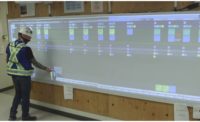Even though tablets and smart phones are spreading onto construction jobsites at a swift pace, chief financial officers from major A/E/C firms say technology purchases must come with solid returns on investment as part of that adoption. This was one of many technology issues highlighted during the two-day ENR FutureTech conference held by McGraw-Hill Construction in San Francisco this week.
Two panel discussions, “Chief Information Officer Roundtable” and “IT from the CFO Perspective,” on Dec. 13 reinforced the industry-wide movement to bring information technology to the job site and free it from a jobsite’s trailer and home office. But how to achieve this for a reasonable cost of ownership, and with the right mix of hardware and software, is a huge debate at firms far and wide across the industry.
John Jacobs, vice president at JE Dunn Construction, Kansas City, said his firm found success in using Microsoft’s collaboration software SharePoint in creating a unique web site for each project that enables all the major players to share data with eachother and update it quickly.
“With SharePoint, team collaboration requires broad-based technical training so that everyone can be on the same page,” Jacobs said. “Educating some subcontractors can take up to three hours, so there is some time investment.”
Like Jacobs, CIOs and one owner on the roundtable panel agreed that software in the field needs to be simplified to accommodate many different skill levels.
“The key to delivery speed is based on training—and useability,” said Paul Audsley, IT director at NBBJ Architects, New York.
Mark Cervenka, facilities manager at the Texas A&M Health Science Center, College Station, Texas, said he has leveraged new technology to also simplify facilities and project management issues.
“We are using iPads and iPhones along with building information modeling and COBie,” Cervenka said. COBie, or Construction Operations Building Information Exchange, saves money by loading equipment and product data during design, construction and commissioning instead of after the project is completed, which has been the industry norm.
David Morris, director of virtual construction at EMCOR, Norwalk, Conn., said his boss, President Tony Guzzi, made his job of selecting technology easier: “He’s an Apple man,” Morris said. “We now have 600 iPads in the field all able to access BIM.”
With CFOs, ROI measurement is key to their jobs overseeing and approving technology purchases.









